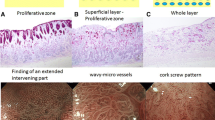Abstract
Background
Pretreatment biopsy may not correctly diagnose mixed-type early gastric cancers. Despite reports on the usefulness of magnifying endoscopy with narrow-band imaging in diagnosing early gastric cancers, no reports exist on differences in magnifying endoscopy with narrow-band imaging findings between differentiated-type-predominant mixed-type and undifferentiated-type-predominant mixed-type early gastric cancers.
Aim
This study aimed to clarify differences in magnifying endoscopy with narrow-band imaging findings and investigate the additive effect of combining magnifying endoscopy with narrow-band imaging and biopsy findings for pretreatment histological-type diagnosis.
Methods
Patients undergoing endoscopic submucosal dissection as initial treatment between April 2005 and March 2017 participated in this retrospective study. There were 156 differentiated-type-predominant mixed-type and 36 undifferentiated-type-predominant mixed-type lesions. We extracted the most significant magnifying endoscopy with narrow-band imaging findings of differentiated-type-predominant mixed-type and undifferentiated-type-predominant mixed-type lesions using multivariate analysis and compared the accuracy, sensitivity, and specificity between pretreatment biopsy alone and a combination of biopsy and magnifying endoscopy with narrow-band imaging findings.
Results
Significant magnifying endoscopy with narrow-band imaging findings was fine network pattern in differentiated-type-predominant and corkscrew pattern in undifferentiated-type-predominant mixed-type lesions. Accuracy, sensitivity, and specificity were significantly higher with combined biopsy and magnifying endoscopy with narrow-band imaging findings than with pretreatment biopsy alone.
Conclusions
The study results demonstrated the additive effect of magnifying endoscopy with narrow-band imaging with biopsy for diagnosing mixed-type early gastric cancers. This study may be beneficial in routine practice because it indicates a possibility of reducing additional surgery after endoscopic submucosal resection because of incorrect diagnosis of histological type.


Similar content being viewed by others
References
Ono H, Kondo H, Gotoda T, et al. Endoscopic mucosal resection for treatment of early gastric cancer. Gut. 2001;48:225–229.
Gotoda T, Kondo H, Ono H, et al. A new endoscopic mucosal resection procedure using an insulation-tipped diathermic knife for rectal flat lesions: report of two cases. Gastrointest Endosc. 1999;50:560–5763.
Ohkuwa M, Hosokawa K, Boku N, Ohtu A, Tajiri H, Yoshida S. New endoscopic treatment for intramucosal gastric tumors using an insulated-tip diathermic knife. Endoscopy. 2001;33:221–226.
Yamamoto H, Kawata H, Sunada K, et al. Success rate of curative endoscopic mucosal resection with circumferential mucosal incision assisted by submucosal injection of sodium hyaluronate. Gastrointest Endosc. 2002;56:507–512.
Japanese Gastric Cancer Association. Japanese gastric cancer treatment guidelines 2014 (ver. 4). Gastric Cancer. 2017;20:1–19.
Gotoda T, Yanagisawa A, Sasako M, et al. Incidence of lymph node metastasis from early gastric cancer: estimation with a large number of cases at two large centers. Gastric Cancer. 2000;3:219–225.
Hirasawa T, Gotoda T, Miyata S, et al. Incidence of lymph node metastasis and the feasibility of endoscopic resection for undifferentiated-type early gastric cancer. Gastric Cancer. 2009;12:148–152.
Allum WH, Blazeby JM, Griffin SM, et al. Association of Upper Gastrointestinal Surgeons of Great Britain and Ireland, the British Society of Gastroenterology and the British Association of Surgical Oncology. Gut. 2011;60:1449–1472.
Thrumurthy SG, Chaudry MA, Hochhauser D, Mughal M. The diagnosis and management of gastric cancer. BMJ. 2013;347:f6367.
Yao K, Anagnostopoulos GK, Ragunath K. Magnifying endoscopy for diagnosing and delineating early gastric cancer. Endoscopy. 2009;41:462–467.
Ezoe Y, Muto M, Uedo N, et al. Magnifying narrowband imaging is more accurate than conventional white-light imaging in diagnosis of gastric mucosal cancer. Gastroenterology. 2011;141:2017–2025.
Muto M, Yao K, Kaise M, et al. Magnifying endoscopy simple diagnostic algorithm for early gastric cancer (MESDA-G). Dig Endosc. 2016;28:379–393.
Yagi K, Nakamura A, Sekine A, Umezu H. Magnifying endoscopy with narrow band imaging for early differentiated gastric adenocarcinoma. Dig Endosc. 2008;20:115–122.
Nakayoshi T, Tajiri H, Matsuda K, Kaise M, Ikegami M, Sasaki H. Magnifying endoscopy combined with narrow band imaging system for early gastric cancer: correlation of vascular pattern with histopathology (including video). Endoscopy. 2004;12:1080–1084.
Yokoyama A, Inoue H, Minami H, et al. Novel narrow-band imaging magnifying endoscopic classification for early gastric cancer. Dig Liver Dis. 2010;42:704–708.
Yagi K, Sato T, Nakamura A, Sekine A. The possibility and limitation of magnifying endoscopic diagnosis using NBI in the extent of undifferentiated intramucosal gastric adenocarcinoma. Stomach Intest. 2009;44:60–70. (in Japanese).
Okada K, Fujisaki J, Kasuga A, et al. Diagnosis of undifferentiated-type early gastric cancers by magnification endoscopy with narrow-band imaging. J Gastroenterol Hepatol. 2011;26:1262–1269.
Horiuchi Y, Fujisaki J, Yamamoto N, et al. Accuracy of diagnostic demarcation of undifferentiated-type early gastric cancers for magnifying endoscopy with narrow-band imaging: endoscopic submucosal dissection cases. Gastric Cancer. 2016;19:515–523.
Takao M, Kakushima N, Takizawa K, et al. Discrepancies in histologic diagnoses of early gastric cancer between biopsy and endoscopic mucosal resection specimens. Gastric Cancer. 2012;15:91–96.
Lim H, Jung HY, Park YS, et al. Discrepancy between endoscopic forceps biopsy and endoscopic resection in gastric epithelial neoplasia. Surg Endosc. 2014;28:1256–1262.
Komatsu S, Ichikawa D, Miyamae M, et al. Discrepancies in the histologic type between biopsy and resected specimens: a cautionary note for mixed-type gastric carcinoma. World J Gastroenterol. 2015;21:4673–4679.
Author information
Authors and Affiliations
Corresponding author
Ethics declarations
Conflicts of interest
There are no conflicts of interest associated with this study.
Research involving human participants and/or animals
The study was approved by the Institutional Review Board (IRB) of our institution (IRB no. 2017-1068). This study was conducted in compliance with the principles of the Declaration of Helsinki and its later amendments. Before recording the data, all personal identification information was removed.
Informed consent
Written informed consent for use of pathological specimens and imaging data for research purposes was obtained from each patient.
Additional information
Publisher's Note
Springer Nature remains neutral with regard to jurisdictional claims in published maps and institutional affiliations.
Rights and permissions
About this article
Cite this article
Horiuchi, Y., Tokai, Y., Yamamoto, N. et al. Additive Effect of Magnifying Endoscopy with Narrow-Band Imaging for Diagnosing Mixed-Type Early Gastric Cancers. Dig Dis Sci 65, 591–599 (2020). https://doi.org/10.1007/s10620-019-05762-9
Received:
Accepted:
Published:
Issue Date:
DOI: https://doi.org/10.1007/s10620-019-05762-9




